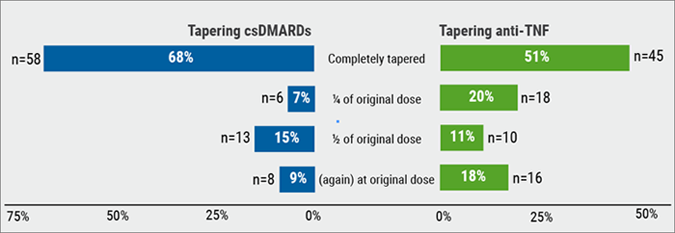https://doi.org/10.55788/0ee82a05
The objective of the “JAK-pot” study presented by statistician Mr Romain Aymon (Geneva University Hospital, Switzerland) was to assess the incidence of MACE in RA patients treated with JAKi, compared with biologic agents in a large, multi- country, real-world population [1]. “With our subgroup analysis, we wanted to replicate the main inclusion criteria of the ORAL Surveillance study”, Mr Aymon explained. In the post- authorisation safety trial ORAL Surveillance (NCT02092467), an increased risk of MACE and venous thromboembolism was found during therapy with tofacitinib versus TNFi in patients with RA and at least 1 additional CV risk factor [2]. It led to issued warnings from both European and US authorities, which raised concern about the safety of JAKi.
The data of the “JAK-pot” study was derived from 14 registries from an international collaboration. Patients starting JAKi, TNFi, or biological DMARDs with other modes of action (OMA, namely abatacept, rituximab, sarilumab, or tocilizumab) were included. A sub-analysis was performed on patients of at least 50 years old and with 1 or more CV risk factors, mimicking the ORAL Surveillance inclusion criteria. The exposure period was from treatment initiation until the first of either: 3 months after discontinuation, start of a new treatment, end of participation in the register, or end of the study period.
Across the 50,325 treatment initiations considered, 182 incident MACE were reported. The study did not find a significantly higher risk of MACE in RA patients treated with JAKi compared with TNFi. “The crude incidence rates for JAKi were lower than for TNFi,” Mr Aymon said. However, the adjusted regression analysis demonstrated no significant difference in the incidence of MACE between JAKi versus TNFi (IRR 0.87; 95% CI 0.56–1.35) and OMA versus TNFi (IRR 1.05; 95% CI 0.74–1.49; see Figure).
Figure: Adjusted IRR for MACE according to treatments in the “JAK-pot” study [1].

TNFi, TNF inhibitors; JAKi, JAK inhibitors; OMA, DMARDs with other modes of action; IRR, incidence rate ratio; CI, confidence interval.
The ORAL Surveillance duplicate cohort accounted for 38.4% of treatment courses and had a higher incidence of MACE in each treatment group. But, similarly to the overall population, there was no significant difference in the incidence rates of MACE observed between JAKi versus TNFi (IRR 0.78; 95% CI 0.44–1.38) and OMA versus TNFi (IRR 0.84; 95% CI 0.53–1.32). “There were no differences in any outcomes, only maybe a small venous thromboembolic event signal in the ORAL Surveillance duplicate cohort,” Mr Aymon concluded.
- Aymon R, et al. Incidence of major adverse cardiovascular events in patients with rheumatoid arthritis treated with JAK-inhibitors compared to bDMARDs: data from an international collaboration of registries (the "JAK-pot" study). OP0219, EULAR 2023, 31 May–3 June, Milan,
- Ytterberg SR, et N Engl J Med. 2022;386:316-26.
Copyright ©2023 Medicom Medical Publishers
Posted on
Previous Article
« Selective JAK1/TYK 2 inhibitor effective in patients with difficult-to-treat RA Next Article
Disease activity-guided dose reduction may be a long-term option for stable RA »
« Selective JAK1/TYK 2 inhibitor effective in patients with difficult-to-treat RA Next Article
Disease activity-guided dose reduction may be a long-term option for stable RA »
Table of Contents: EULAR 2023
Featured articles
Late-breaking Oral Abstracts
Selective JAK1/TYK 2 inhibitor effective in patients with difficult-to-treat RA
Novel 2-drug combo improves treatment possibilities for patients with refractory gout
Dazodalibep improves dryness, fatigue, and pain in patients with Sjögren’s syndrome with a high symptom burden
COVID-19: Young adults with auto-immune diseases have different risks than their healthy counterparts
RA in 2023
Poly-refractory RA: not common, but still present
AI almost as successful as experts in predicting early RA
Worse self-management in patients with inflammatory arthritis in the presence of comorbid anxiety or depression
Disease activity-guided dose reduction may be a long-term option for stable RA
Cardiovascular safety of JAK inhibitors: reassuring results from a real-world study
Spondylarthropathies: New Developments
AxSpA: Adalimumab biosimilar equally effective as IL-17 inhibitor in hindering radiographic progression
Vascular inflammation may be characteristic of PsA
Obesity in PsA is increasingly affecting male patients
PsA patients: highest risk of developing NAFLD
What is Hot in Osteoarthritis
Lorecivivint shows long-term benefits for severe knee OA
Methotrexate lowers pain in inflammatory hand OA
Systemic Sclerosis: State of the Art
Targeted DMARDs advantageous in SSc patients with pre-capillary pulmonary hypertension
Osteoporosis: New Data
Drugs for osteoporosis: time to reach fracture risk reduction varies
Romosozumab: the new option for glucocorticoid-induced osteoporosis with high fracture risk?
Best of the Posters
Therapy with biological DMARDs shows no correlation with fracture risk in RA
Basic Science
In vitro and in vivo studies confirm the role of regulatory volume decrease
Related Articles

August 14, 2020
COVID-19 and inflammatory rheumatic disease: some key issues

© 2024 Medicom Medical Publishers. All rights reserved. Terms and Conditions | Privacy Policy
HEAD OFFICE
Laarderhoogtweg 25
1101 EB Amsterdam
The Netherlands
T: +31 85 4012 560
E: publishers@medicom-publishers.com

